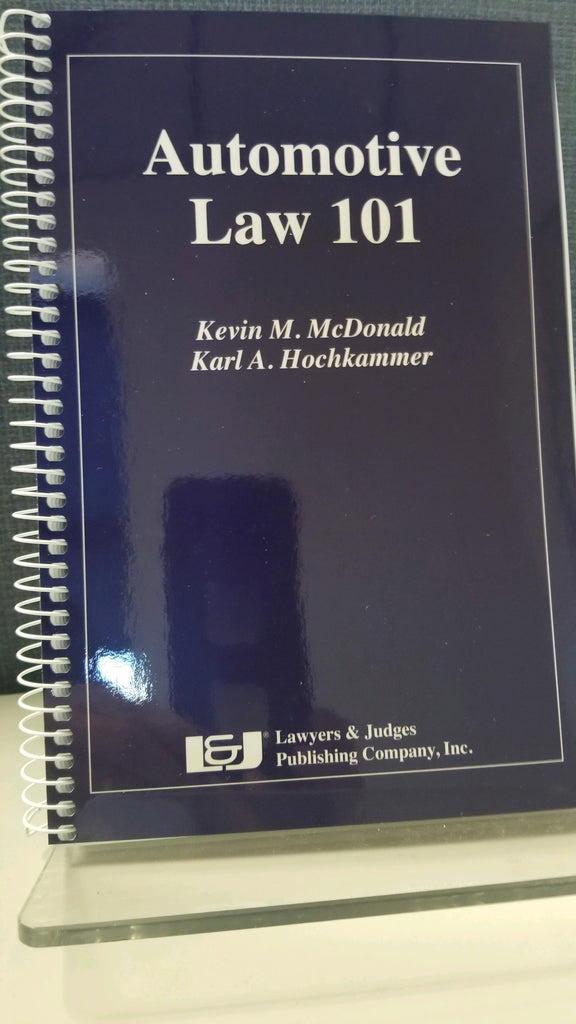
Automotive Law 101: 101 Answers to Frequently Asked Questions
The financial crisis of 2008-9 wiped out General Motors and Chrysler, several major automakers paid dearly in the wake of self-inflicted product scandals, and new companies such as Tesla emerged as serious challengers to the traditional car manufacturers and to the traditional dealership model. Yet despite these changes, what hasn't changed is the basic legal structure governing how a car must be designed, manufactured, sold, and serviced in order to meet various consumer protection laws. And still I can't find a handbook or comprehensive guide to automotive law that is intended to educate consumers about how the law protects them when they purchase or lease an automobile. That's why Karl and I wrote this book. It is our modest attempt to provide a high-level guide to all major aspects making up a field we call "automotive law." Automotive law is that body of law governing the design, manufacturing, sale, and servicing of an automobile. In no particular order, automotive law draws from contract law, administrative law, tort law, products liability law, securities law, environmental law, consumer protection law, financial law, intellectual property law, patent law, and antitrust law, all depending on where one is within the lifecycle of an automobile transaction, broadly defined (meaning production through after-sales). We have divided the various constituents of automotive law into bite-size chapters that summarize how these areas feed into a whole of automotive law using a "Frequently Asked Questions" approach. The way we conceptualized this undertaking is by starting with the engineering and design and ending with the servicing. The book is thus divided into four parts. Part One covers the legal aspects involved in selling an automobile, from the engineering and design through the selling and distribution, including marketing and advertising. Part Two focuses on the myriad laws and regulations involved in financing the purchase of an automobile. Part Three covers the legal aspects of fixing an automobile, from warranties to lemon law and recalls, including products liability. Part Four concludes the book by looking into the future at the law governing emerging sales and financing models such as autonomous vehicles, car sharing models, and alternative payment platforms. For whom is this book written? It's for anyone, lawyers and non-lawyers alike, who is interested in the auto industry. It's for the over seven million people employed in the auto sector, from anyone working at an automaker to anyone at one of the suppliers or dealerships. It's for the journalists and academics following this important industry. It's for the new entrants seeking to "disrupt" the traditional method of building, distributing, or selling cars. It's for anyone interested in seeing how all the aspects of the legal system fit into a body of law called automotive law. And last, but certainly not lease, it's written to educate consumers about how automotive law protects them. Although this book is not intended to serve as an exhaustive hornbook and intentionally does not all aspects of automotive law applicable to manufacturers and suppliers and the automotive supply chain, we hope that it can serve as a quick reference guide that provides the reader a simple and accessible primer on automotive law. Think of it as a quick-tips guide that accompanies the standard owner's manual in your car. Before reading the owner's manual, you probably read the quick-tips guide. That's what this book is designed to do by serving as a quick-tips guide to automotive law and to point you in the right direction if you're interested in diving into the details in any particular area. A few words on parlance. We use the terms "automobile," "vehicle," and "car" interchangeably. Technically, of course, not all "vehicles" are "automobiles." And not all "cars" are "vehicles." For purposes of my explanations, though, this technicality won't make any difference.
5-Star Review
When I’m reading for work, I want a book that’s complete, concise and accurate. Automotive Law 101 by Kevin M. McDonald and Karl A. Hochkammer hits all three points. This book is a primer on everything: the laws governing auto design and engineering, distribution, warranties, sales, class actions, privacy and more. Moreover, it is well documented with hundreds of endnotes—and that’s something that’s very important to me. If I need to find the source of certain information for a legal brief, it’s there. If you’re dealing with automobiles in your practice, this is the go-to guide. James Nesci, Esq.




